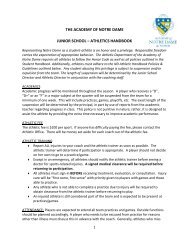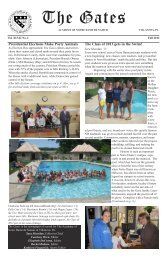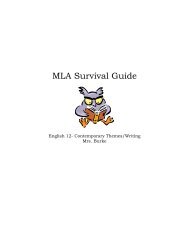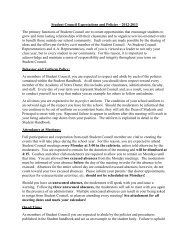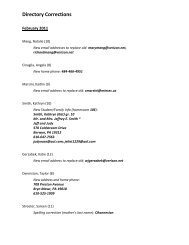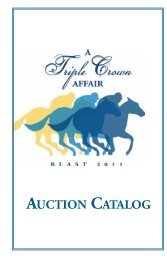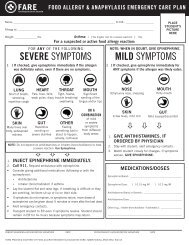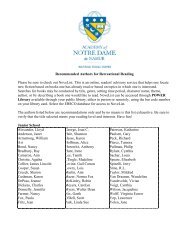Head Lice Information
Head Lice Information
Head Lice Information
Create successful ePaper yourself
Turn your PDF publications into a flip-book with our unique Google optimized e-Paper software.
<strong>Head</strong> <strong>Lice</strong> <strong>Information</strong><br />
The adult head louse is 2 to 3 mm long (the size of a sesame seed), has 6 legs, and is usually<br />
tan to grayish-white in color. The female lives up to 3 to 4 weeks and, once mature, can lay up<br />
to 10 eggs per day. These tiny eggs are firmly attached to the base of the hair shaft within<br />
approximately 4 mm of the scalp with a glue-like substance produced by the louse. Viable eggs<br />
camouflaged with pigment to match the hair color of the infested person often are seen more<br />
easily at the posterior hairline. Empty egg casings (nits) are easier to see because they appear<br />
white against darker hair. (Note that some experts refer to “eggs” as containing the developing<br />
nymph and use “nits” to refer to empty egg casings; others use the term “nits” to refer to both<br />
eggs and the empty casings.) The eggs are incubated by body heat and typically hatch in 8 to 9<br />
days, but hatching can vary from 7 to 12 days depending on whether the ambient climate is hot<br />
or cold. Once it hatches, a nymph leaves the shell casing and passes through a total of 3 nymph<br />
stages (instars) during the next 9 to 12 days and then reaches the adult stage. The female louse<br />
can mate and begin to lay viable eggs approximately 1.5 days after becoming an adult. If not<br />
treated, this cycle may repeat itself approximately every 3 weeks. The louse feeds by injecting<br />
small amounts of saliva with vasodilatory and anticoagulation properties and sucking tiny<br />
amounts of blood from the scalp every few hours. Itching results from sensitization to<br />
components of the saliva. With a first case of head lice, itching may not develop for 4 to 6<br />
weeks, because it takes that amount of time for sensitivity to result. <strong>Head</strong> lice usually survive for<br />
less than 1 day away from the scalp at room temperature, and their eggs cannot hatch at an<br />
ambient temperature lower than that near the scalp.<br />
<strong>Head</strong> lice, unlike body lice, do not transmit any disease agent. Itching can develop in a<br />
sensitized individual. Rarely, scratching may cause impetigo or other skin infection, which can<br />
lead to local adenopathy<strong>Lice</strong> cannot hop or fly; they crawl. However, there are reports that<br />
combing dry hair can build up enough static electricity to physically eject an adult louse from an<br />
infested scalp more than 1 m. Transmission in most cases occurs by direct contact with the<br />
head of an infested individual. Indirect spread through contact with personal belongings of an<br />
infested individual (combs, brushes, hats) is much less likely but may occur rarely. <strong>Lice</strong> found<br />
on combs are likely to be injured or dead, and a healthy louse is not likely to leave a healthy<br />
head unless there is a heavy infestation. This is further illustrated by 2 studies from Australia. In<br />
1 study, examination of carpets on 118 classroom floors found no lice despite more than 14000
live lice found on the heads of 466 children using these classrooms. In a second study, live lice<br />
were found on only 4% of pillowcases used by infested volunteers. Thus, the major focus of<br />
control activities should be to reduce the number of lice on the head and to lessen the risks of<br />
head-to-head contact.<br />
Treatment<br />
Treatment for head lice is recommended for persons diagnosed with an active infestation. All<br />
household members and other close contacts should be checked; those persons with evidence<br />
of an active infestation should be treated. Some experts believe prophylactic treatment is<br />
prudent for persons who share the same bed with actively-infested individuals. All infested<br />
persons (household members and close contacts) and their bedmates should be treated at the<br />
same time.<br />
Retreatment of head lice usually is recommended because no approved pediculicide is<br />
completely ovicidal. To be most effective, retreatment should occur after all eggs have hatched<br />
but before before new eggs are produced. The retreatment schedule can vary depending on<br />
whether the pediculicide used is ovicidal (whether it can kill lice eggs).<br />
When treating head lice, supplemental measures can be combined with recommended<br />
medicine (pharmacologic treatment); however, such additional (non-pharmacologic) measures<br />
generally are not required to eliminate a head lice infestation. For example, hats, scarves, pillow<br />
cases, bedding, clothing, and towels worn or used by the infested person in the 2-day period<br />
just before treatment is started can be machine washed and dried using the hot water and hot<br />
air cycles because lice and eggs are killed by exposure for 5 minutes to temperatures greater<br />
than 53.5°C (128.3°F). Items that cannot be laundered may be dry-cleaned or sealed in a<br />
plastic bag for two weeks. Items such as hats, grooming aids, and towels that come in contact<br />
with the hair of an infested person should not be shared. Vacuuming furniture and floors can<br />
remove an infested person's hairs that might have viable nits attached.<br />
Treat the infested person(s): Requires using an over-the-counter (OTC) or prescription<br />
medication. Follow these treatment steps:<br />
• Before applying treatment, it may be helpful to remove clothing that can become wet or<br />
stained during treatment.<br />
• Apply lice medicine, also called pediculicide, according to the instructions contained in the<br />
box or printed on the label. If the infested person has very long hair (longer than shoulder<br />
length), it may be necessary to use a second bottle. Pay special attention to instructions on<br />
the label or in the box regarding how long the medication should be left on the hair and how<br />
it should be washed out.
WARNING:<br />
Do not use a combination shampoo/conditioner, or conditioner before using lice medicine. Do<br />
not re-wash the hair for 1-2 days after the lice medicine is removed.<br />
• Have the infested person put on clean clothing after treatment.<br />
• If a few live lice are still found 8-12 hours after treatment, but are moving more slowly than<br />
before, do not retreat. The medicine may take longer to kill all the lice. Comb dead and any<br />
remaining live lice out of the hair using a fine-toothed nit comb.<br />
• If, after 8-12 hours of treatment, no dead lice are found and lice seem as active as before,<br />
the medicine may not be working. Do not retreat until speaking with your health care<br />
provider; a different lice medicine (pediculicide) may be necessary. If your health care<br />
provider recommends a different pediculicide, carefully follow the treatment instructions<br />
contained in the box or printed on the label.<br />
• Nit (head lice egg) combs, often found in lice medicine packages, should be used to comb<br />
nits and lice from the hair shaft. Many flea combs made for cats and dogs are also effective.<br />
• After each treatment, checking the hair and combing with a nit comb to remove nits and lice<br />
every 2-3 days may decrease the chance of self-reinfestation. Continue to check for 2-3<br />
weeks to be sure all lice and nits are gone.<br />
• Retreatment generally is recommended for most prescription and non-prescription (over-thecounter)<br />
drugs on day 9 in order to kill any surviving hatched lice before they produce new<br />
eggs. However, if using the prescription drug malathion, which is ovicidal, retreatment is<br />
recommended after 7-9 days ONLY if crawling bugs are found.<br />
Supplemental Measures :<br />
<strong>Head</strong> lice do not survive long if they fall off a person and cannot feed. You don't need to spend<br />
a lot of time or money on housecleaning activities. Follow these steps to help avoid reinfestation<br />
by lice that have recently fallen off the hair or crawled onto clothing or furniture.<br />
• Machine wash and dry clothing, bed linens, and other items that the infested person wore or<br />
used during the 2 days before treatment using the hot water (130°F) laundry cycle and the<br />
high heat drying cycle. Clothing and items that are not washable can be dry-cleaned<br />
OR<br />
sealed in a plastic bag and stored for 2 weeks.<br />
• Soak combs and brushes in hot water (at least 130°F) for 5-10 minutes.<br />
• Vacuum the floor and furniture, particularly where the infested person sat or lay. However,<br />
the risk of getting infested by a louse that has fallen onto a rug or carpet or furniture is very<br />
small. <strong>Head</strong> lice survive less than 1-2 days if they fall off a person and cannot feed; nits<br />
cannot hatch and usually die within a week if they are not kept at the same temperature as<br />
that found close to the human scalp. Spending much time and money on housecleaning<br />
activities is not necessary to avoid reinfestation by lice or nits that may have fallen off the<br />
head or crawled onto furniture or clothing.<br />
• Do not use fumigant sprays; they can be toxic if inhaled or absorbed through the skin.
Over-the-counter Medications<br />
Many head lice medications are available "over-the-counter" without a prescription at a local<br />
drug store or pharmacy. Each over-the-counter product approved by the FDA for the treatment<br />
of head lice contains one of the following active ingredients. If crawling lice are still seen after a<br />
full course of treatment contact your health care provider.<br />
1. Pyrethrins combined with piperonyl butoxide;<br />
Brand name products: A-200*, Pronto*, R&C*, Rid*, Triple X*.<br />
Pyrethrins are naturally occurring pyrethroid extracts from the chrysanthemum flower.<br />
Pyrethrins are safe and effective when used as directed. Pyrethrins can only kill live lice,<br />
not unhatched eggs (nits). A second treatment is recommended on day 9 to kill any newly<br />
hatched lice before they can produce new eggs. Pyrethrins generally should not be used<br />
by persons who are allergic to chrysanthemums or ragweed. Pyrethrin is approved for use<br />
on children 2 years of age and older.<br />
2. Permethrin lotion 1%;<br />
Brand name product: Nix*.<br />
Permethrin is a synthetic pyrethroid similar to naturally occurring pyrethrins. Permethrin<br />
lotion 1% is approved by the FDA for the treatment of head lice. Permethrin is safe and<br />
effective when used as directed. Permethrin kills live lice but not unhatched eggs.<br />
Permethrin may continue to kill newly hatched lice for several days after treatment. A<br />
second treatment often is necessary on day 9 to kill any newly hatched lice before they<br />
can produce new eggs. Permethrin is approved for use on children 2 months of age and<br />
older.<br />
Prescription Medications<br />
The following medications approved by the U.S. Food and Drug Administration (FDA) for the<br />
treatment of head lice are available only by prescription. If crawling lice are still seen after a full<br />
course of treatment contact your health care provider.<br />
1. Malathion lotion 0.5%;<br />
Brand name product: Ovide*<br />
Malathion is an organophosphate. Malathion lotion 0.5% is approved by the FDA for the<br />
treatment of head lice. The formulation of malathion approved in the United States for the<br />
treatment of head lice is a lotion that is safe and effective when used as directed.<br />
Malathion is pediculicidal (kills live lice) and partially ovicidal (kills some lice eggs). A
second treatment is recommended if live lice still are present 7-9 days after treatment.<br />
Malathion is intended for use on persons 6 years of age and older. Malathion can be<br />
irritating to the skin and scalp; contact with the eyes should be avoided. Malathion lotion is<br />
flammable; do not smoke or use electrical heat sources, including hair dryers, curlers, and<br />
curling or flat irons, when applying malathion lotion and while the hair is wet.<br />
More on: Malathion<br />
2. Benzyl alcohol lotion (5%);<br />
Brand name product: Ulesfia lotion*<br />
Benzyl alcohol is an aromatic alcohol. Benzyl alcohol lotion 5% is a white topical lotion<br />
approved by the FDA for the treatment of head lice; it is considered safe and effective<br />
when used as directed. Benzyl alcohol kills live lice (it is pediculicidal) but does not kill<br />
unhatched lice eggs (it is not ovicidal). A second treatment with benzyl alcohol lotion is<br />
necessary on day 9 after the first treatment (or as recommended by the manufacturer) to<br />
kill any newly hatched lice before they can produce new eggs. Benzyl alcohol lotion is<br />
intended for use on persons who are 6 months of age and older. Benzyl alcohol can be<br />
irritating to the skin and eyes; contact with the eyes should be avoided.<br />
3. Lindane shampoo 1%;<br />
Brand name products: None available<br />
Lindane is an organochloride. The American Academy of Pediatrics (AAP) no longer<br />
recommends it as a pediculocide. Although lindane shampoo 1% is approved by the FDA<br />
for the treatment of head lice, it is not recommended as a first-line therapy. Overuse,<br />
misuse, or accidentally swallowing lindane can be toxic to the brain and other parts of the<br />
nervous system; its use should be restricted to patients for whom prior treatments have<br />
failed or who cannot tolerate other medications that pose less risk. Lindane should not be<br />
used to treat premature infants, persons with HIV, a seizure disorder, women who are<br />
pregnant or breast-feeding, persons who have very irritated skin or sores where the<br />
lindane will be applied, infants, children, the elderly, and persons who weigh less than 110<br />
pounds.
When treating head lice<br />
1. Do not use extra amounts of any lice medication unless instructed to do so by your<br />
physician and pharmacist. The drugs used to treat lice are insecticides and can be<br />
dangerous if they are misused or overused.<br />
2. Do not treat an infested person more than 2-3 times with the same medication if it does not<br />
seem to be working. This may be caused by using the medicine incorrectly or by resistance<br />
to the medicine. Always seek the advice of your health care provider if this should happen.<br />
He/she may recommend an alternative medication.<br />
3. Do not use different head lice drugs at the same time unless instructed to do so by your<br />
physician and pharmacist.<br />
Sources:<br />
http://www.cdc.gov/parasites/lice/head/<br />
http://pediatrics.aappublications.org/content/126/2/392.full (American Journal of Pediatrics)





